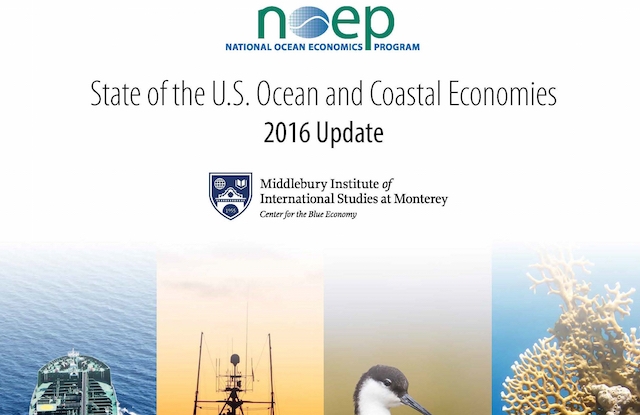New Report Warns of Potential “Disaster” Ahead for Coastal Economies

“A recipe for disaster” is how Dr. Judith Kildow, director of the National Ocean Economics Program (NOEP) at the Middlebury Institute’s Center for the Blue Economy, describes the combination of continuing coastal development, increasing climate change impacts on the coast, and reduced federal resources to mitigate these tensions.
New data on the economic health of the ocean and coastal economies suggest that future growth will largely take place in the narrow band of coastal lands threatened by climate change and sea level rise. The new “State of the U.S. Ocean and Coastal Economies” report from NOEP notes that:
- Coastal regions account for more than 80 per cent of the total U.S. economy.
- The ocean-related economy will likely continue to outpace the overall national economy in growth.
- Population patterns are shifting so that major cities, most located in coastal areas, are growing. These coastal regions will bear the brunt of most future growth at a time when the impacts of climate change are accelerating.
- While growth in coastal and ocean economies continued at the same time that threats to ocean health increase, federal resources directed at understanding and managing these resources declined.
The report utilizes a new tool, the Ocean Economy Coincident Index, to calculate that the ocean-related economy is likely to continue to outpace the overall national economy in growth.
The compilation of data through 2014 demonstrates that most major ocean economy sectors were strong, except for a decline in living resources, primarily seafood harvesting and processing. The report—available for download on the NOEP website—notes that the major driver of that growth through 2014 was in offshore oil, gas, and minerals that was fueled by rapidly rising oil prices.
“However, that rising trend has obviously changed, with oil and gas prices tumbling in late 2015 and early 2016,” said Kildow. “It bears close watching to see how this new development plays out over time.”
Kildow also said that while growth in coastal and ocean economies continued at the same time that threats to ocean health increase, federal resources directed at understanding and managing these resources declined. “Federal resources in fiscal year 2016 are at essentially the same level in dollars, $20.8 billion, as five years earlier,” she noted.
“Something has to change,” says Center for the Blue Economy Director Jason Scorse, who also chairs the Institute’s International Environmental Policy program. “We have to be much more proactive about rethinking our relationship with the coasts if these engines of growth are going to continue to thrive. If not, America is in big trouble.”
For More Information
Jason Warburg
jwarburg@middlebury.edu
831.647.3156
Eva Gudbergsdottir
eva@middlebury.edu
831.647.6606
